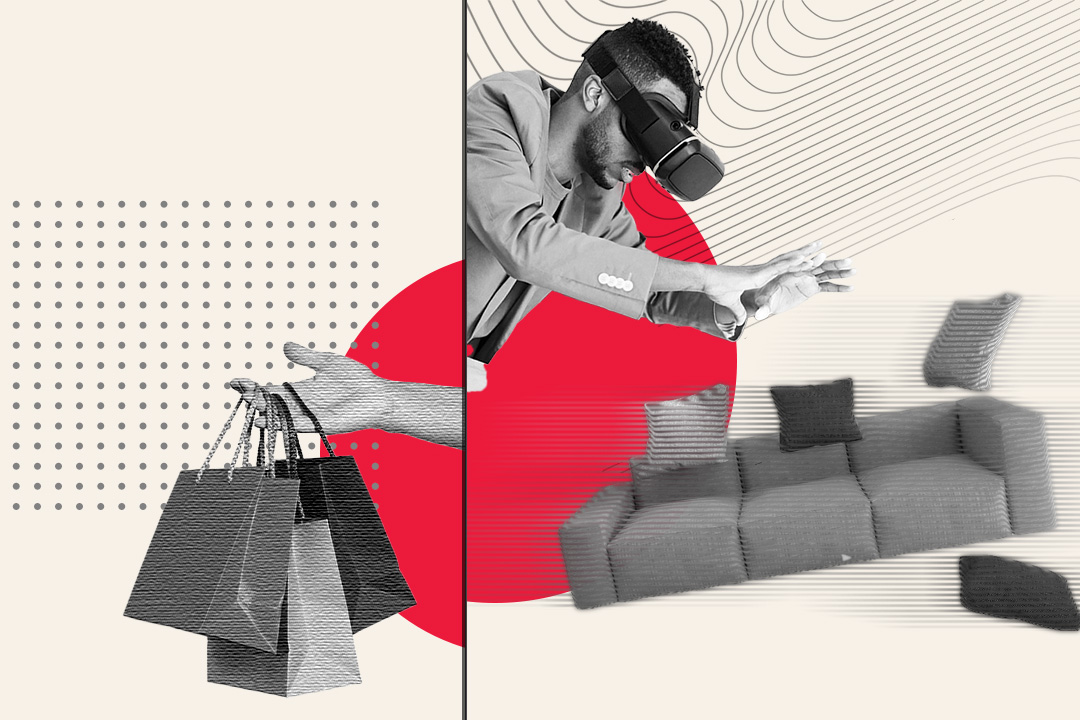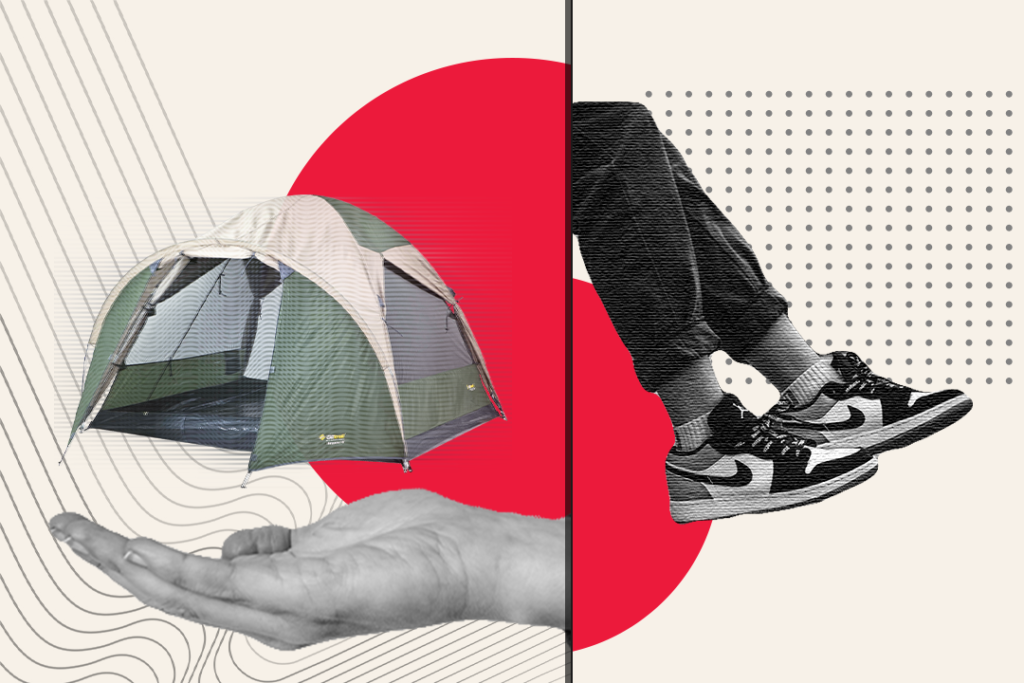Canadian Tech Companies Are Sparking a Retail Revolution

Back in 2019, Sophie Howe, co-founder and CEO of Xesto, felt like she was rolling a boulder uphill. Sure, the company was creating innovative tech that could revolutionize online shopping—but landing that all-important first customer? No dice.
The startup, which grew out of research conducted at the University of Toronto, was working on something new for the footwear e-commerce space: a software tool that uses a smartphone’s facial ID camera to create 3D reconstructions of customers’ feet. Suddenly, online customers could know within seconds if those size-eight KEENs or Nikes would actually fit them.
Howe expected the tool would be an easy sell with retailers. Not only was the solution brilliant in its simplicity—3D-video scanning was ubiquitous in new phones by then—but accurate foot measurements could dramatically slash online returns, a huge problem for the industry. Between 30 and 40 per cent of all footwear bought online are sent back, she says, often on the company’s dime.
But when Howe reached out to potential clients asking them to commit some financial support, the retailers asked her to come back when the tool was ready to launch. Then they’d decide.
“It was like, ‘Let me see when you’re working with the big guys.’ And then the big guys were like, ‘Let me see when you’re working with our competitors,’” she says, explaining that e-commerce just wasn’t on their radar.
That is, until the pandemic hit. Then people started returning her calls.
“Everything changed overnight,” she says.
That shift was felt right across the retail sector. According to Statistics Canada data, retail e-commerce sales nearly doubled between February and May 2020 when they reached a record $3.9 billion, and companies scrambled to find ways to make online shopping easier and more enticing. Many of those technologies stuck. Today, Xesto is used by thousands of customers and is moving into the wristwatch space, offering quick 3D wrist measurements, handy for smartwatches with slip-on bands in multiple sizes. Full body scans may be next. (Say goodbye to wriggling into jeans in a claustrophobic changeroom. Score.)
“Pre-existing and new trends have accelerated tremendously in the past two years,” says Kostya Polyakov, national industry leader for consumer and retail at KPMG Canada. “The retail sector, in particular, is undergoing a radical shift.” In response to Covid-19 lockdowns and general unease about shopping in public, the pandemic has lit a firecracker under retail technology that might have otherwise taken years to come to fruition. As Polyakov says, “augmented reality, artificial intelligence and chatbots, the adoption rate has just spiked.”
In other words, we’ve actually come to like these new innovations—even prefer them to traditional shopping mall retail. From Calgary-based Nobal, which creates interactive mirrors and turns shoppers into digital avatars that can try on different clothing styles and sizes, to HaptX in California, which uses virtual reality and robotics to simulate touch, technological innovations are picking up speed as more retailers latch on. And they’re becoming ever more immersive and sophisticated.
A custom experience
Companies in the luxury market, in particular, have had to reimagine their businesses to incorporate more technology. Before the pandemic, many luxury brands didn’t even bother with e-commerce sites. The focus was always on superb in-person service. But suddenly, they needed systems that would allow for online purchases and in-store pick-ups, as well as ways for sales associates to chat with their best clients to book appointments.
“Before, these were all seen as nice-to-haves,” says Ali Asaria, president and CEO of Tulip, a fast-growing point-of-sale software company based in Kitchener, Ont., which works with high-end retailers including Coach and Tiffany & Co. “Then Covid hit, and it was, ‘OK, the last 10 things we’ve been talking about that we’d do over five years? We need to do them in five months.’”
How are things changing? Imagine your favourite store knows what style, fit and colours you prefer—and then a sales associate sends you a text, instant message, WhatsApp note or calls to give you bespoke recommendations for the latest products and news about upcoming lines. Forget those annoying generic corporate e-blasts. This time it’s personal. One of Tulip’s apps also installs a widget on the retailer’s website so clients can book one-on-one appointments with sales associates.
As online purchasing becomes more convenient, the in-store retail experience will have to evolve, too. That means ensuring that online and in-store inventory merges so a customer can check whether their local store has what they want before hopping in the car. Polyakov calls this “connected enterprise,” explaining that large retailers already have the capability for digital integration that will show you their inventory levels, pick-up availability times—and even in which aisle to find the item. But smaller and mid-size chains will have to step up in order to compete.
They can’t take a “lipstick on a pig approach to digital or e-commerce,” he says. “Next-level digital integration is an absolute must today.”
Even further, the online and real worlds could eventually collide with live salespeople giving personalized advice online. Polyakov calls this merger of physical and digital worlds, “phygital.”
All of these innovations will likely mean shrinking real estate footprints for stores as retailers turn to appointment shopping or showroom models. Think fewer SKUs and products, while sharing onsite storage space with other nearby stores.

Augmented reality takes off
Pawel Rajszel of Leap Tools in Toronto has also seen a sharp increase in interest in its Roomvo app, which offers users a way to visualize anything from furniture and carpets to paint colours and flooring in your own space. Shopping at, say, Crate & Barrel online? Simply snap a photo of your room, and use the Roomvo tool that’s seamlessly integrated into the retailer’s website. Voila. There’s the new lamp beside your favourite comfy chair.
Looking to the future, Rajszel believes tools like this will become the norm, rather than the exception. Particularly as Roomvo rolls out new capabilities like being able to give personalized advice about matching pre-existing furniture with new decor pieces. He sees the industry upping the AI game.
“Frankly, we’re really at the beginning,” he says. “We’re just scratching the surface with all these capabilities and making the experience better for the consumers.”
Polyakov agrees, describing a world where—after some innovative hardware updates—we’ll shop for a sofa online and then use our phone or laptop to project a life-size, 3D image on the floor to see how it will work in our space. Or we’ll purchase a tent, project it, and lie down “inside” to check dimensions and see how it, well, feels. Customers will likely come to expect these types of extra services that will make online shopping for problematic items like furniture, rugs or, yes, jeans and shoes, easier.
“Augmented and virtual reality will one hundred per cent be a bigger part of shopping,” Polyakov says.
Retailers immersed in the metaverse
Chatbots are becoming more sophisticated, too. Polyakov points to the customized experience that Nestlé Toll House has created with Ruth, its new AI-powered assistant. Just list what you’ve got in your fridge and pantry and the humanoid baker on your screen gives suggestions on what recipes to try (featuring the company’s products, of course).
But chatbots are but an entryway to the dawn of the next age of connectivity and visualization, explains Polyakov, who sees retail exploding in the digital metaverse space, an immersive real-time parallel reality.
What would that look like? A much richer sensory experience than the current version of shopping in the virtual space. (Let’s face it. You can’t throw pennies in a mall fountain while shopping online or catch up with friends. But that’s possible in the metaverse.) Video game players are already used to spending real money to upgrade outfits or equipment in their digital worlds—might they also be persuaded to shop in-game for real jeans that get delivered the next day? Or maybe we’ll all don virtual reality haptic gloves so we can feel how soft a new sofa is, because the real one is three time zones away. Although we’re still years away from that, visualization, avatar and connectivity technologies are pushing us in that direction.
Companies such as Gucci are already snatching up space on The Sandbox, a digital theme park, while metaverse platform Decentraland is set to host its first Metaverse Fashion Week from March 24, with dozens of global brands and thousands of users virtually connecting at fashion shows and after parties, swishing around in digital couture. Meanwhile, Warner Music Group is set to host star-studded virtual concerts on The Sandbox, expected to draw millions of concertgoers. It doesn’t take much imagination to see how fans could be tempted to purchase real clothes or merch at these events, too.
Some experts predict the metaverse is set to become the next Internet, and Polyakov agrees. “Humans are going to spend more time online, more time in the digital world,” he says. “It’s the gamification of life.”
